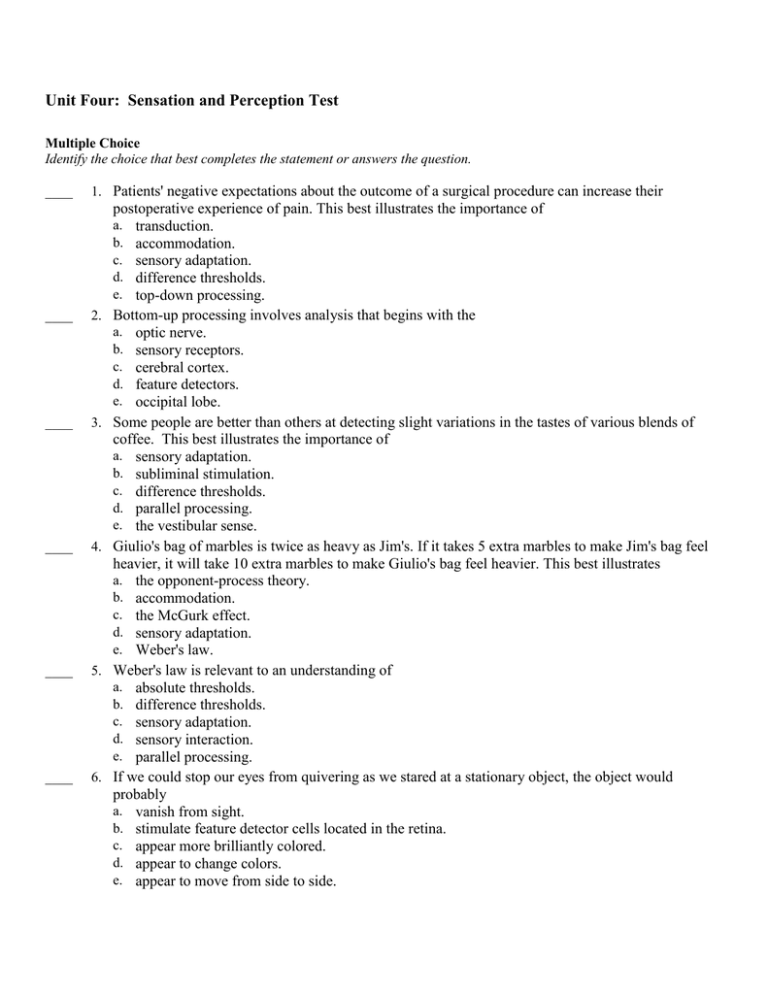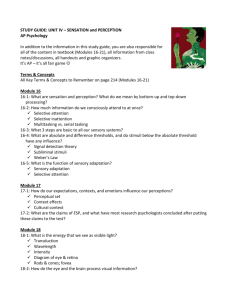Unit 4 Test
advertisement

Unit Four: Sensation and Perception Test Multiple Choice Identify the choice that best completes the statement or answers the question. ____ 1. Patients' negative expectations about the outcome of a surgical procedure can increase their ____ 2. ____ 3. ____ 4. ____ 5. ____ 6. postoperative experience of pain. This best illustrates the importance of a. transduction. b. accommodation. c. sensory adaptation. d. difference thresholds. e. top-down processing. Bottom-up processing involves analysis that begins with the a. optic nerve. b. sensory receptors. c. cerebral cortex. d. feature detectors. e. occipital lobe. Some people are better than others at detecting slight variations in the tastes of various blends of coffee. This best illustrates the importance of a. sensory adaptation. b. subliminal stimulation. c. difference thresholds. d. parallel processing. e. the vestibular sense. Giulio's bag of marbles is twice as heavy as Jim's. If it takes 5 extra marbles to make Jim's bag feel heavier, it will take 10 extra marbles to make Giulio's bag feel heavier. This best illustrates a. the opponent-process theory. b. accommodation. c. the McGurk effect. d. sensory adaptation. e. Weber's law. Weber's law is relevant to an understanding of a. absolute thresholds. b. difference thresholds. c. sensory adaptation. d. sensory interaction. e. parallel processing. If we could stop our eyes from quivering as we stared at a stationary object, the object would probably a. vanish from sight. b. stimulate feature detector cells located in the retina. c. appear more brilliantly colored. d. appear to change colors. e. appear to move from side to side. ____ 7. Intensity is to brightness as wavelength is to a. accommodation. b. frequency. c. amplitude. d. hue. e. disparity. ____ 8. The adjustable opening in the center of the eye is the a. fovea. b. iris. c. cornea. d. pupil. e. blind spot. ____ 9. The most light-sensitive receptor cells are the a. ganglion cells. b. cones. c. bipolar cells. d. rods. e. iris. ____ 10. Damage to the fovea would have the greatest effect on a. night vision. b. peripheral vision. c. visual acuity. d. sensory adaptation. e. kinesthesis. ____ 11. Sound wave vibrations are transmitted by three tiny bones located in the a. vestibular sacs. b. semicircular canals. c. inner ear. d. cochlea. e. middle ear. ____ 12. The volley principle is most directly relevant to our perception of a. temperature. b. color. c. brightness. d. pain. e. pitch. ____ 13. Joe Wilson, age 55, has been told by experts that a hearing aid would restore his lost sense of hearing. It is likely that Joe's hearing loss involves problems within the a. inner ear. b. middle ear. c. auditory nerve. d. basilar membrane. e. oval window. ____ 14. Researchers have identified receptors for which of the following skin sensations? a. pain b. c. d. e. ____ 15. ____ 16. ____ 17. ____ 18. ____ 19. ____ 20. cold warmth pressure hot A football player was tackled hard during a very physical game, but he did not feel any pain until the post-game celebration party. Which of the following best explains this phenomenon? a. Phantom pain sensations occur when the brain misinterprets spontaneous central nervous system activity. b. Psychological factors, such as distraction, can diminish pain sensations. c. Small nerve fibers in the spinal cord were activated, stopping the pain signals. d. Sensors in the kinesthetic system released pain-killing endorphins. e. The process of accommodation delayed pain sensations from reaching the brain. Mr. Kim's experience of chronic back pain is influenced by his cultural background, his attentional processes, and nerve damage caused by an automobile accident. An integrated understanding of Mr. Kim's suffering is most clearly provided by a. Weber's law. b. the phi phenomenon. c. opponent-process theory. d. a biopsychosocial approach. e. perceptual constancy. Taste and smell are both what kind of senses? a. vestibular b. kinesthetic c. energy d. chemical e. perceptual One of the ways we perceive images is by organizing stimuli into an object seen against its surroundings. What is this perceptual tendency called? a. opponent-process theory b. binocular cue c. retinal disparity d. figure-ground e. sensory adaptation Almost half the birds in the yard were brown cardinals and the rest were bright red cardinals, so Jimmy perceived them as two distinct groups of birds. This best illustrates the principle of a. proximity. b. closure. c. similarity. d. connectedness. e. disparity. A 3-D movie enhances our sense of depth perception by simulating the effects of a. interposition. b. retinal disparity. c. linear perspective. d. perceptual constancy. e. gestalt cues. ____ 21. The perception that Bugs Bunny is hopping across a movie screen best illustrates a. the Müller-Lyer illusion. b. retinal disparity. c. the Ponzo illusion. d. stroboscopic movement. e. opponent-process. ____ 22. Knowing about the effects of the perceived distance of objects on their perceived size helps us to understand a. the Moon illusion. b. the McGurk effect. c. prosopagnosia. d. phantom limb sensations. e. parallel processing. ____ 23. After chicks were fitted with special lenses that visually displaced objects to the left, they a. quickly learned to compensate by pecking to the left of where the food appeared to be. b. only gradually learned to compensate by pecking to the right of where the food appeared to be. c. only gradually learned to compensate by pecking to the left of where the food appeared to be. d. never adapted to the visual distortion. e. immediately adapted and pecked successfully at the food. ____ 24. Stereotypes are mental conceptions that can strongly influence the way we interpret the behaviors of individuals belonging to specific racial or ethnic groups. A stereotype is most similar to a. a feature detector. b. perceptual adaptation. c. a perceptual set. d. a difference threshold. e. gate-control theory. ____ 25. To those throwing a very heavy rather than a light object at a target, the target is likely to be perceived as a. softer. b. slower moving. c. larger. d. farther away. e. more difficult.



